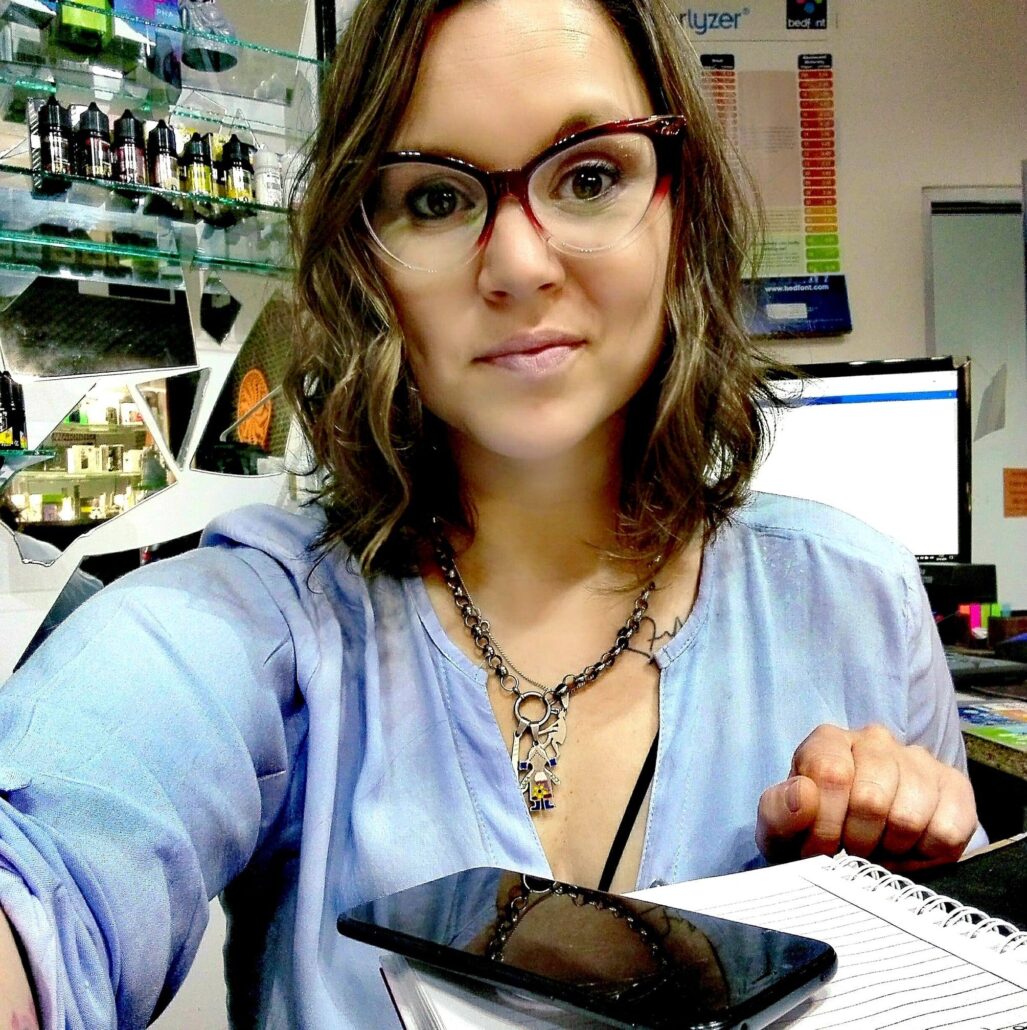Mara Marcik is one of those figures who quietly emerge from the margins and quickly become leading voices in their field.
Hailing from the colorful and vibrant city of Corrientes—a place marked by the scars of tobacco use on both the body and society—Mara has evolved into a prominent activist and entrepreneur in a cause that many prefer to avoid: harm reduction associated with tobacco consumption and the pressing need to educate and inform.
As the CEO of Buddha Vape Corrientes and an independent consultant, she has dedicated her career to promoting safe and responsible practices in an industry that is predominantly male and as controversial as it is essential in the fight for public health. However, her work goes beyond her roles as an activist and entrepreneur.
Mara has been selected by the prestigious KAC’s THR Scholarship program, a global recognition aimed at training future leaders in tobacco harm reduction.
Through her “Reliable Store Manual” project, she has taken on the mission of raising awareness among vape shop retailers and advisors about their crucial role in their customers’ health and trust.
With the support of medical experts and sociologists, she is developing a manual that aims to ensure product quality and user safety and incorporates sustainable practices and responsible waste management.
Moreover, her vision extends beyond Argentina’s borders; she aspires to establish quality standards that vape shops worldwide can adopt.
In this interview, we explore her motivations, the challenges she anticipates, and her vision for the future of an industry that, from her perspective, has the potential to transform the relationship between commerce and public health.

~ You’ve been deeply involved in the vaping industry in Argentina, both as a user and a consultant. What initially attracted you to this field, and how has the direction you’ve taken in your career shaped your personal and professional trajectory?
MM – My journey into vaping started with a direct recommendation from my primary care physician, who also became a pivotal mentor in my life. I owe him countless hours of selfless education, which allowed me to have a successful and enjoyable experience.
I was a heavy smoker with multiple failed attempts to quit tobacco. Moreover, I belonged to a community entirely unaware of this harm-reduction tool.
Like any unknown method, vaping initially stirred a mix of emotions in me: intrigue, fear, and skepticism, especially since the WHO itself questioned its effectiveness.
However, a crucial factor rarely mentioned… my daughter’s right, then very young, to live in a safe and healthy home and have a mother in good health.
This motivated me to try it, especially because the information came from a trusted person who cared about my health—a dedicated professional.
Realizing the potential and effectiveness of vaping in helping people quit smoking, I decided to become more involved in the community, sharing my experiences and knowledge.
This involvement led me to take on an empathetic role with others—users like myself—who had tried to quit smoking with many methods but without success. I learned the importance of advising others on the best practices and products.
Working in this field has shaped my career, guiding me toward a blend of education and activism.
I’ve focused on promoting awareness, safety, and informed use of vaping while also trying to advocate, in my modest capacity, for regulations that protect both consumers and responsible manufacturers—something that, unfortunately, has yet to be achieved in Argentina.
~ As the CEO of Buddha Vape Corrientes and an independent activist, how do you balance the commercial challenges of running a business with your strong commitment to tobacco harm reduction (THR) and the well-being of users?
MM – From the outset, I committed to ensuring that Buddha operates responsibly. I understand that balance is achieved by maintaining a focus on ethics, education, the individual needs of each user, and adaptability while prioritizing the mission of harm reduction.
This approach has allowed Buddha to be more than just a place to buy products; it’s also a space where information, support, and proper guidance are provided to ensure that the chosen method is used correctly.
Additionally, we raise awareness even among those who don’t need vaping, recognizing that historically, any prohibition tends to spark a challenging interest, and prohibitionist methods have never been successful.
~ Your project focuses on creating a “Reliable Store Manual” to raise awareness among retailers and advisors about their responsibility to ensure the safety and quality of products. Could you elaborate on the challenges you foresee in implementing these guidelines in stores with different levels of knowledge and contextual realities?
Vape shop advisors can have varying levels of knowledge about vaping, harm reduction, and current regulations. Some may be experts, while others could be new to the industry.
Unfortunately, this often leads to users having poor experiences or making choices unsuitable for their needs.
Implementing new guidelines might meet with resistance, especially if advisors are unaware that they are working directly with users’ health and psychological well-being.
It’s disheartening that the lack of proper regulation allows advisors without the necessary knowledge to harm consumers directly.
Changing established practices requires effort and persuasion. A proactive, flexible, and collaborative approach can overcome these significant challenges.
The ultimate goal is for all stores to offer safe and quality products while promoting proper harm-reduction practices, which will benefit both businesses and users.
~ One of the goals of your project is the challenge of establishing a network of reliable stores that adhere to safety standards. How do you plan to implement and ensure compliance with these standards, especially in regions with varying levels of regulation and oversight?
Yes, establishing a network of reliable stores that meet safety standards in the vaping industry is indeed a significant challenge, especially as we are part of an industry that has historically been neglected and left to self-regulate, mainly with the help of scientists dedicated to public education.
Without clear legislative regulations, this requires a structured and adaptive approach, particularly given the varied regulatory contexts across different regions.
Thanks to the information provided by scientists, I’ve created a set of safety and quality standards that are clear, specific, and applicable to any vape shop, regardless of location.
These standards will cover aspects such as product authenticity, safe storage, staff training, and the information provided to users.
Regardless of each user’s level of knowledge, it is our duty as advisors to educate.
The goal is to unify this information in multiple languages to maintain consistency and establish an effective communication structure.
To this end, I will provide both printed and digital support materials to each store or industry entrepreneur who wishes to participate in the project.
~ Your project also emphasizes the importance of proper waste management and recycling. How do you plan to integrate these environmental practices in an effective and appealing way to store owners and consumers?
Integrating environmental practices like proper waste management and recycling into vape shops is essential to protect the environment and enhance business sustainability and consumer perception.
Projects aimed at recycling and creating a circular economy are currently ongoing, and I want to support those working in this area.
Integrating these practices can become a competitive differentiator, attracting environmentally conscious customers.
By combining education, incentives, and collaboration with the community, we can ensure that store owners and consumers feel motivated to participate actively in these initiatives.
~ You mention collaboration with sociologists and doctors, like Dr. Diego Verrastro, to ensure the accuracy of the information provided in your manual. How do you envision this interdisciplinary approach contributing to the effectiveness and impact of your project?
The combination of medical evidence with a deep understanding of social behavior can serve as a foundation for raising awareness about the advisor’s role and supporting future regulations that are effective and grounded in harm reduction.
Working with experts enables implementing more robust evaluation systems that consider both health outcomes and the social impacts of vaping.
Having doctors like Dr. Diego Verrastro collaborate ensures that the information related to health, harm reduction, and vaping usage is based on the latest evidence. This increases the credibility of the manual and guarantees that users receive safe and reliable information.
As you mentioned, this interdisciplinary approach enhances the quality of the manual’s content and ensures that the recommendations are practical, applicable, and tailored to the realities of the stores and their customers.
This increases the project’s effectiveness in its goal of creating a network of reliable and safe stores, significantly contributing to harm reduction in society.
~ Given the global scope of your project, what strategies do you plan to use to adapt your guidelines and practices to different cultural environments and regulatory frameworks?
As I mentioned, adapting a global project like creating a “Reliable Store Manual” for the vaping industry to different cultural environments and regulatory frameworks is a complex challenge, but not impossible.
I intend to develop communication strategies that resonate with the cultural sensitivities of each region.
This includes adapting language, images, and messages to be culturally appropriate and appealing.
It’s also crucial to be flexible in implementation, designing the manual with sections that can be customized or adapted according to each region’s specific needs.
This way, stores can maintain a global standard while complying with local nuances.

~ What metrics will you use to evaluate the success of your project? Could you share some specific indicators that will allow you to measure whether your goals, such as improving user health and implementing responsible practices, are being met?
One of the metrics to develop would be an open platform for both users and advisors.
This platform would generate evidence through user self-reports about improvements in their health and a reduction in the number of vaping-related incidents, such as a decrease in reports of adverse events (inadequate nicotine dosing, device failures, etc.).
Another key indicator would be the percentage of stores actively implementing and maintaining recycling programs for devices, cartridges, and batteries, as well as the number of stores that have joined the “Reliable Stores” network and maintained their certification over time.
Additionally, the number of employees who have completed training on responsible practices, safety, and harm reduction will be measured.
These indicators would provide reliable support for users and demonstrate the industry’s seriousness.
~ In the long term, how do you expect your project to influence the broader conversation on tobacco harm reduction and the role of vape shops in public health?
In the long term, I hope my project will significantly impact the global conversation on tobacco harm reduction by establishing a reference model for how vape shops can be key players in promoting public health.
My goal for this project is to drive the implementation of rigorous standards, responsible practices, and greater recognition of vape shops as safe spaces where users receive proper guidance and quality products that contribute to reducing health risks.
The project could establish a regulatory model and best practices that other regions or countries might adopt by creating and disseminating the “Manual” and certifying stores.
This model could undoubtedly serve as a foundation for regulatory frameworks, equipping both consumers and shop owners with the knowledge and tools necessary to make informed and conscious decisions about using harm-reduction products.
~ As vaping and tobacco harm reduction tools continue to be debated globally, what ethical considerations guide your work, particularly when it comes to promoting these products as safer alternatives to traditional tobacco?
Ethical considerations are fundamental in any work related to public health, especially in controversial fields such as vaping and tobacco harm reduction tools.
Being completely transparent about these devices’ benefits and true purpose as risk-reduction tools is crucial.
This means communicating clearly and accurately that while vaping may be significantly less harmful than combustible tobacco, it is not risk-free.
Therefore, providing balanced information in all educational materials and interactions with customers is essential, ensuring they understand the advantages and that it is not a healthy habit.
It is a tool intended for adult smokers who want to minimize the risks and harm to themselves and their surroundings.
All potential users should have equal access to accurate and evidence-based information about vaping, regardless of their socioeconomic status or geographic location. Freedom of choice is a global right.
~ How do you respond to the concerns of critics who argue that promoting vaping could lead to unintended consequences, such as increased use among youth or the normalization of nicotine use?
It’s a complex and much-debated issue, but it’s crucial to implement and enforce strict regulations to prevent minors from accessing vaping products.
Just as with tobacco (which unfortunately isn’t always adequately controlled), laws must ensure that vaping is not accessible to youth.
In my view, the key lies in education about the risks and proper use of vaping products, and this should be a priority.
Ensuring that young people are well-informed about the potential risks of vaping can help prevent misuse.
Prohibitionist actions only foster misinformation, an uncontrolled market, and leave young people even more unprotected, underestimating their intelligence and awareness.
I suggest we look at it from another perspective.
We talk about protecting young people and our fear of normalizing nicotine use, but we overlook the fact that many young people and children live in homes with smokers, constantly exposed to health risks.
We don’t allow them to raise awareness among their peers and elders.
Providing information is not endorsing consumption; it’s akin to banning bakeries because childhood and adolescent obesity rates have quadrupled globally between 1990 and 2022.
Instead of banning, we should promote education and awareness of healthy habits.
Let’s respect the rights the WHO reminds us of, such as access to information, education, and a healthy and safe life. This also applies to their environment.

